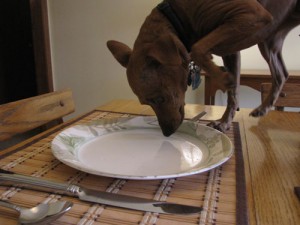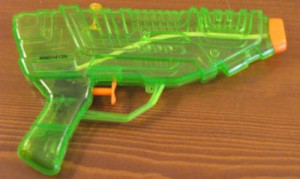Be Careful What You Teach Your Dog
Our dogs are learning from us all the time. Everything you do or don’t do regarding your dog trains them. Do you feed them from the table occasionally? Do you allow them on the furniture? Do you give a command and not enforce it? Your dog learns from each of those actions. Miniature Pinschers, because of their independent thinking, can be especially difficult. Thus, in addition to love and attention, Miniature Pinschers need firm guidance. Otherwise, you will have an unruly and obnoxious canine on your hands. This post outlines some common mistakes dog owners make when training a dog.
Ways to Teach Your Dog to be a Pest
- Feed it from the table.
Does your dog give you a “hopeful” look while you are at the dinner table? That hopeful look is actually a dominance stare. Min Pins are especially prone to dominance issues and thus anything to deter dominant behavior is a top priority. If you must give your dog a small amount of table food, wait until after dinner, make the dog down and stay, and feed it from its own food bowl. Allow it to eat only after you give the release command. You have just reinforced your dominance in two important ways. First, you ate before the dog. Alpha dogs always eat first. Second, you required the dog to submit to you (the down and stay command) before it ate. These steps are good practice at every meal time. We feed our dogs immediately after our meal and make them down and stay until released. You may think that it is impossible to make your dogs down and stay when food is involved, but they may catch on quicker than you think. Getting their food depends on it, after all.A well-trained dog will make no attempt to share your lunch. He will just make you feel so guilty that you cannot enjoy it.
-Helen Thomson -
Let it lick your face occasionally.
You have likely heard of positive and negative reinforcement, but have you heard of intermittent? Intermittent reinforcement is actually the most powerful of the three. By allowing the dog to do anything “sometimes” it makes the dog think that the next time it tries, it might receive the desired “reward.” In this case it is getting to lick your face. This is the same type of reinforcement that gamblers get at slot machines and at least part of why they are so addictive. Thus, the intermittent reinforcement is stimulating powerful reward centers in your dog’s brain.
-
Let it on the furniture.
You may decide to allow your dogs on the furniture–that decision is up to you. We like our dogs on our lap while we watch TV and thus choose to deal with any ensuing dominance issues in other ways. However, it is not fair to the dog to sometimes allow it on the furniture and scold it for the same thing at other times. One must be consistent when training dogs. (Note: Telling it go get off the furniture but not enforcing it is allowing it on the furniture.) I do have one word of caution, though. Wherever you allow your dog to lay will become ITS spot. For example, Athena now shares her queen sized bed with my husband and me.
-
Keep the word “no” a secret.
We adopted our latest dog about a year ago. Three months after we got him, he developed “youngest child syndrome” and was quite a handful. I reluctantly got out the water gun–our “enforcer.” Nano had no idea what the piece of plastic was. It was then that I realized that I had never told him “no.” He received firm but fair remedial training, and although he can still be a handful at times, he does understand the word “no.”
-
Let it chew on inappropriate things.
Do you have an old shoe that you let your dog chew? Are you then surprised when the dog chews all the shoes in your closet? Put this in your dog’s perspective: Your dog can’t tell the difference between old and new shoes. Your dog does, however, need appropriate chews at all times. If it is chewing an inappropriate object, a tried and true method is redirection. In a gruff voice, say “no.” Then in a sweet, high pitched voice, say “chew this.” With consistency and repetition, your dog will learn which chews are appropriate.
-
Give a command but don’t enforce it.
This is the single most super-duper whopper of a mistake there is. Not enforcing a command undermines all other training you might do because it teaches your dog not to take you seriously. As a dog owner, you know how much time and energy is required to enforce commands, especially at first. However, this is an investment that will pay big dividends. I like to use positive reinforcement when I can. However, negative reinforcement is often necessary, also. I like to use a water gun. The dog typically hates it, but it is not physically painful. Thus, results are usually quick effective.
[yop_poll id=”3″]
Making Rules
The rules of your house are uniquely your own. You will want to set them to fit with your lifestyle. However, a consistent set of rules for your dog is a must. Your dog operates by routine and thus, it is not fair to the dog to change its rules frequently. In addition, your dog will be better able to obey you if it understands the rules.
Rules should be planned, not made out of haste, and they should have behavior modification in mind. It is better that an undesirable behavior go uncorrected once than to impose an ineffective punishment. Here is one example: we have had trouble with our dogs wanting to go outside to play during the middle of the night. We took several days to think of an effective way to modify their behavior because we did not want to ban them from going to the bathroom in the middle of the night if that is what they needed to do. Thus, we decided that we would let them out, but if they did not use the bathroom, they were crated for the rest of the night. This worked surprisingly well. I think that we hit a “pack” instinct–being isolated from the pack is bad punishment, and to be avoided.
Your Role as a Teacher
Dogs do not automatically know how you expect them to behave in the house. You must teach them. Dogs operate by routine, and your dog will be much calmer and happier if its routine, including its rules, are stable. When training your dog, think of your favorite teacher in school, and be as kind and patient as he or she was with you. Your relationship with your dog will be better for it.








